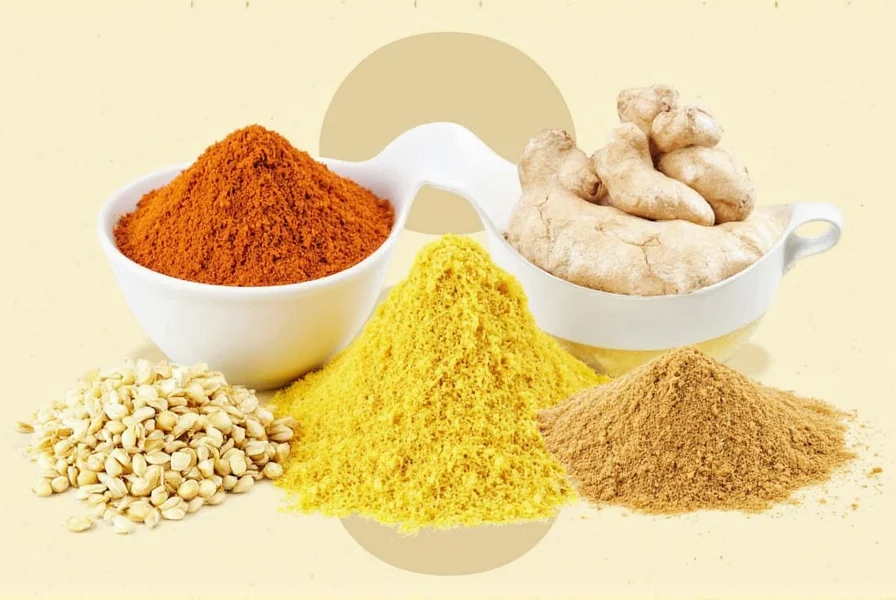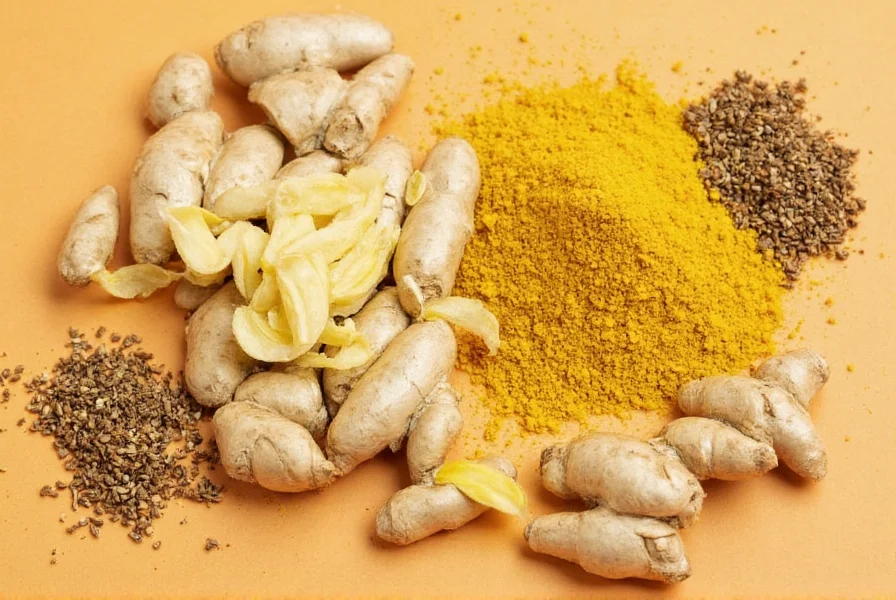When your recipe calls for ginger but your pantry is empty, knowing effective alternatives can save your cooking project. Whether you're out of fresh ginger, dealing with dietary restrictions, or simply seeking different flavor profiles, understanding proper ginger substitutes ensures your dishes maintain their intended character. This guide explores practical alternatives for various culinary applications, from baking to savory cooking, with precise measurements and flavor considerations.
Top Ginger Substitutes for Different Culinary Applications
Ginger's unique flavor profile—combining warmth, spice, and slight citrus notes—makes it challenging to replace perfectly. However, several alternatives work well depending on your specific needs and the dish you're preparing. The right substitute depends on whether you need fresh, dried, or ground ginger, and whether your recipe is sweet or savory.
Fresh Ginger Alternatives
When a recipe specifically calls for fresh ginger, these options provide the closest approximation of texture and flavor:
- Galangal: Often called 'Thai ginger,' this rhizome offers a sharper, more citrusy flavor. Use in equal amounts for Southeast Asian dishes but avoid in sweet recipes.
- Horseradish: Provides similar heat but lacks ginger's sweetness. Best for savory dishes at half the amount of ginger called for.
- Lemongrass: Offers citrus notes but milder heat. Use 2 stalks lemongrass for every tablespoon of ginger in Thai or Vietnamese cuisine.
- Fresh Turmeric: Provides earthy warmth and vibrant color but less spice. Substitute at a 1:1 ratio with awareness of its stronger staining properties.
| Substitute | Best For | Ratio | Flavor Notes |
|---|---|---|---|
| Ground ginger | Baking, spice blends | 1/4 tsp = 1 tbsp fresh | Less citrus, more earthy |
| Allspice | Pumpkin pie, gingerbread | 1/2 tsp = 1 tbsp fresh | Complex spice profile |
| Cinnamon + Cardamom | Cookies, cakes | 1/4 tsp each = 1 tbsp fresh | Warm but less spicy |
| Ginger extract | Beverages, delicate dishes | 1/2 tsp = 1 tbsp fresh | Concentrated flavor |
Dried and Powdered Ginger Replacements
When your recipe requires ground ginger, these alternatives work well in baking and spice mixes:
Allspice makes an excellent ginger substitute for baking, particularly in gingerbread and pumpkin pie recipes. Its complex flavor profile contains notes reminiscent of cinnamon, nutmeg, and cloves. For best results when seeking a ginger replacement in baking, use half the amount of allspice compared to the ginger called for in your recipe.
Cinnamon and cardamom combination creates a surprisingly effective ginger alternative for sweet dishes. This non-spicy ginger substitute works particularly well in cookies and cakes where you want warmth without intense heat. Try using equal parts of both spices to replace ground ginger.
Ginger extract provides concentrated flavor without the fibrous texture of fresh ginger. This ginger replacement in recipes works especially well for beverages and delicate sauces where texture matters. Use half the amount of extract compared to fresh ginger for optimal results.

Specialized Substitutes for Specific Applications
Different cooking contexts require tailored ginger alternatives. Understanding these specialized substitutes ensures your dishes maintain their intended character:
Ginger Substitute for Stir Fry
For Asian stir-fries, galangal provides the closest flavor match but can be difficult to find. When seeking a ginger substitute for stir fry, try using horseradish at half the amount for heat, combined with a squeeze of lime for the citrus notes ginger provides. This combination works particularly well in Thai and Chinese dishes where ginger's sharpness cuts through rich sauces.
Allergy-Friendly Ginger Alternatives
For those with ginger allergies, finding safe alternatives requires careful consideration. Turmeric offers similar color without the allergenic compounds, while mace provides warmth without related allergens. When exploring allergy-friendly ginger alternatives, start with small amounts and adjust to taste, as these substitutes have distinct flavor profiles.
Non-Spicy Ginger Replacement
If you need the flavor without the heat, consider using a combination of lemon zest and a touch of cinnamon. This non-spicy ginger replacement works well in dishes where children will be eating or for those sensitive to spicy foods. For every tablespoon of fresh ginger, use the zest of half a lemon plus 1/8 teaspoon cinnamon.

When Ginger Substitutes Won't Work
Some recipes rely so heavily on ginger's unique properties that substitutes fall short. Traditional ginger beer, certain Ayurvedic remedies, and authentic Japanese gari (pickled ginger) require the real ingredient for proper results. In these cases, no ginger substitute for baking or cooking will deliver the authentic experience. Understanding these limitations helps manage expectations when ingredient substitution becomes necessary.
Remember that successful substitution depends on your specific needs—whether you're looking for the best ginger substitute for baking, a fresh ginger alternative for cooking, or a replacement for medicinal purposes. The right choice varies based on your recipe's requirements and your personal taste preferences.
Conclusion
Having multiple ginger alternatives in your culinary toolkit ensures you can adapt to any cooking situation. The best substitute depends on your specific application—galangal for Southeast Asian dishes, allspice for baking, or horseradish for heat in savory applications. When measuring how much turmeric equals ginger or determining proper ratios for other substitutes, start conservatively and adjust to taste. With these alternatives, you'll never have to abandon a recipe due to missing ginger.
Frequently Asked Questions
What's the best ginger substitute for baking?
Allspice works best as a ginger substitute for baking, particularly in gingerbread and pumpkin pie recipes. Use half the amount of allspice compared to the ginger called for in your recipe. For a more complex flavor, try combining equal parts cinnamon and cardamom.
Can I use turmeric instead of ginger?
Yes, turmeric makes a good visual substitute for ginger with similar earthy notes, but it lacks ginger's citrusy heat. Use fresh turmeric at a 1:1 ratio for color, but add a squeeze of lemon to compensate for missing citrus notes. Be aware that turmeric stains more intensely than ginger.
How much ground ginger equals fresh ginger?
Use 1/4 teaspoon of ground ginger for every tablespoon of fresh ginger called for in your recipe. Ground ginger has a more concentrated, earthier flavor with less citrus notes, so you may want to add a small amount of lemon zest to compensate for the flavor difference.
What's a good non-spicy ginger replacement?
For a non-spicy ginger replacement, try combining lemon zest with a touch of cinnamon. Use the zest of half a lemon plus 1/8 teaspoon cinnamon for every tablespoon of fresh ginger. This works well in dishes for children or those sensitive to spicy foods while maintaining some of ginger's characteristic warmth.
Can I substitute ginger in stir fry?
Yes, for stir fry, use horseradish at half the amount of ginger called for, plus a squeeze of lime juice to mimic ginger's citrus notes. Galangal makes an excellent ginger substitute for stir fry in Thai and Vietnamese cuisine, but it has a sharper, more floral flavor than ginger.











 浙公网安备
33010002000092号
浙公网安备
33010002000092号 浙B2-20120091-4
浙B2-20120091-4